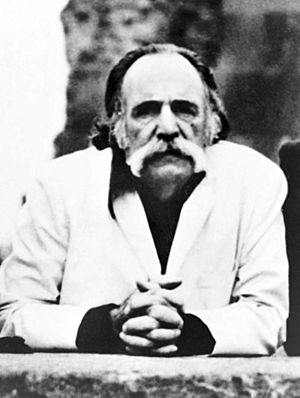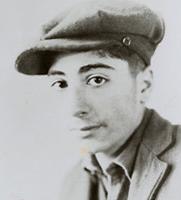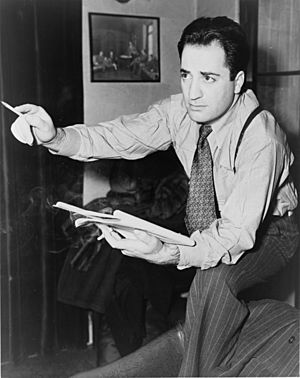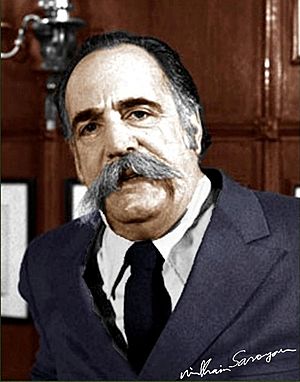William Saroyan facts for kids
Quick facts for kids
William Saroyan
|
|
|---|---|

Saroyan in the 1970s
|
|
| Born | August 31, 1908 Fresno, California, U.S. |
| Died | May 18, 1981 (aged 72) Fresno, California, U.S. |
| Resting place | Ararat Cemetery, Fresno Komitas Pantheon, Yerevan, Armenia |
| Occupation |
|
| Period | 1934–1980 |
| Notable works | The Armenian and the Armenian (1935) My Heart's in the Highlands (1939) The Time of Your Life (1939) My Name Is Aram (1940) The Human Comedy (1943) |
| Notable awards | Pulitzer Prize for Drama (1940) Academy Award for Best Story (1943) |
| Spouse |
Carol Grace
(m. 1943; div. 1949)
(m. 1951; div. 1952) |
| Children |
|
| Relatives | Ross Bagdasarian (cousin) |
| Signature | |
 |
|
William Saroyan (born August 31, 1908 – died May 18, 1981) was an American writer. He was a novelist, playwright, and short story writer. His family came from Armenia.
Saroyan won the Pulitzer Prize for Drama in 1940. He also won an Academy Award in 1943 for the story of the film The Human Comedy. When the movie studio didn't like his first story idea, he turned it into a novel. Many people think Saroyan was one of the most important writers of the 20th century.
He wrote a lot about the lives of Armenian immigrants in California. Many of his stories and plays take place in his hometown of Fresno, California. Some of his famous works include The Time of Your Life, My Name Is Aram, and My Heart's in the Highlands. His short story collections from the 1930s, Inhale Exhale and The Daring Young Man On the Flying Trapeze, are considered very important.
Contents
About William Saroyan's Life
Early Years and Family Background
William Saroyan was born on August 31, 1908. His birthplace was Fresno, California. His parents, Armenak and Takuhi Saroyan, were immigrants from Armenia.
When William was three years old, his father passed away. William and his brother and sister went to live in an orphanage in Oakland, California. He later wrote about his time there in his books. Five years later, his family was together again in Fresno. His mother, Takuhi, found work at a cannery. William taught himself and worked different jobs to support himself.
Saroyan decided to become a writer after his mother showed him some of his father's old writings. Some of his first short articles were printed in a magazine called Overland Monthly. His first stories came out in the late 1920s. One of these was "The Broken Wheel," published in an Armenian journal. Many of Saroyan's stories were about his childhood. They often featured Armenian-American fruit growers in the San Joaquin Valley. His book My Name is Aram (1940) was a worldwide bestseller. It was about a young boy and his interesting immigrant family. This book has been translated into many languages.
Becoming a Famous Writer
Saroyan became well-known as a writer with his story "The Daring Young Man on the Flying Trapeze" in 1934. The title came from an old song. The story was about a young, struggling writer during the Great Depression.
The money he earned from a collection of his stories allowed Saroyan to travel. He visited Europe and Armenia. He once said, "Try to learn to breathe deeply; really to taste food when you eat, and when you sleep really to sleep. Try as much as possible to be wholly alive with all your might, and when you laugh, laugh like hell." Saroyan wanted his writing to be full of life. His unique writing style became known as "Saroyanesque."
Saroyan's stories from this time often showed the difficulties of the Great Depression. He wrote very quickly and didn't change his words much.
He also published essays and memoirs, which are like personal stories. In these, he wrote about people he met on his travels. These included the writer George Bernard Shaw and the artist Charlie Chaplin. In 1952, Saroyan published The Bicycle Rider in Beverly Hills. This was the first of several books where he shared his own experiences. He often used his life as inspiration for his plays.
His first play, My Heart's in the Highlands (1939), was a comedy about a young boy and his Armenian family. It was performed in New York. He is most famous for his play The Time of Your Life (1939). This play takes place in a saloon in San Francisco. It won a Pulitzer Prize. Saroyan refused the prize because he believed art should not be judged by money. However, he did accept another award for the play. This play was later made into a movie in 1948.
Before World War II, Saroyan worked on a movie script called The Human Comedy (1943). This film is set in a made-up California town. It tells the story of a young telegraph messenger named Homer. He sees the sad and happy parts of life during the war.
The movie studio, MGM, thought Saroyan's script was too long. Saroyan didn't want to change it, so he was removed from directing the film. He then turned his script into a novel. He published the novel just before the movie came out. He won an Academy Award for Best Story for the film's story. People often think the movie was based on the novel, but it was actually the other way around. After this experience, he never allowed Hollywood to make movies from his novels again.
Saroyan served in the United States Army during World War II. He was stationed in New York and later in London. After the war, some people thought his novels were too sentimental. They felt his ideas about freedom and kindness didn't fit the times. Still, he wrote a lot.
One of Saroyan's most successful projects was a song. He wrote "Come On-a My House" in 1939 with his cousin Ross Bagdasarian. It became a huge hit for singer Rosemary Clooney in 1951.
Saroyan also enjoyed painting. He said he made drawings before he learned to write. His abstract paintings were shown in galleries. From 1958, William Saroyan mostly lived in Paris. In his later years, he earned more money and paid off his debts. In 1979, he was honored by being added to the American Theater Hall of Fame.
Personal Life and Legacy
In 1943, Saroyan married actress Carol Grace. They had two children, Aram and Lucy. Aram later became an author and wrote a book about his father. Lucy became an actress. Saroyan and Carol divorced in 1949. They remarried in 1951 but divorced again in 1952.
William Saroyan passed away in Fresno, California, at age 72. He had prostate cancer. Half of his ashes were buried in California. The other half were buried in Armenia, near other famous artists.
Remembering William Saroyan
- In 2008, a statue was put up in honor of Saroyan in Yerevan, Armenia.
- In 2014, a street in Bitlis, Turkey, was renamed "William Saroyan Street."
- In 2015, several libraries were opened in Bitlis, Turkey, in his honor.
- On August 31, 2018, the William Saroyan House Museum opened in Fresno, California. This was the house where Saroyan lived for his last 17 years. The museum shows photos, drawings, and book covers. It even has a special room with a hologram of the writer.
- In 1991, the USA and the USSR released stamps with William Saroyan's picture.
- The Central Bank of Armenia has released coins and banknotes featuring William Saroyan.
- In 1988, a small alley in San Francisco was renamed William Saroyan Place.
Awards and Honors
- In 1940, William Saroyan won the Pulitzer Prize for Drama for his play The Time of Your Life. He chose not to accept the award.
- In 1943, William Saroyan received an Academy Award for his story for the film The Human Comedy.
- In 2013, Saroyan was honored after his death with the Parajanov-Vartanov Institute Award. This was for his play The Time of Your Life and his novel Human Comedy.
See also
 In Spanish: William Saroyan para niños
In Spanish: William Saroyan para niños





